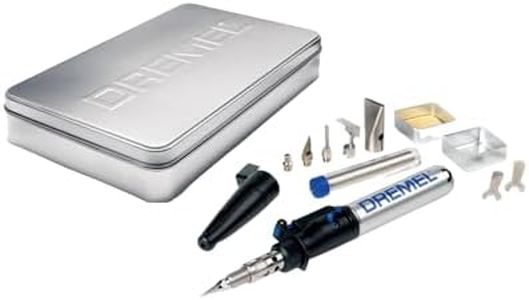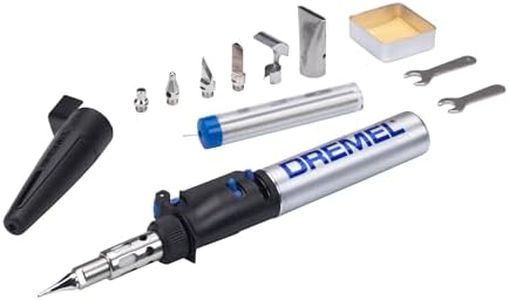We Use CookiesWe use cookies to enhance the security, performance,
functionality and for analytical and promotional activities. By continuing to browse this site you
are agreeing to our privacy policy
7 Best Butane Soldering Iron
From leading brands and best sellers available on the web.Buying Guide for the Best Butane Soldering Iron
Choosing a butane soldering iron is all about finding a tool that matches both the type of work you plan to do and your comfort with soldering. Butane soldering irons are valued for their portability and independence from mains electricity, making them perfect for fieldwork, automotive tasks, or quick repairs where plugging in a corded iron isn’t practical. The key is to consider where and how often you'll use it, as well as the kinds of joints or repairs you'll tackle. By understanding the main features, you can confidently select a soldering iron that will be safe, reliable, and efficient for your needs.Heating Power (BTU/Watt Equivalent)Heating power in a butane soldering iron determines how quickly the tip reaches working temperature and how well it maintains heat during use. This matters because stronger heating power allows you to solder a wider range of components, including larger wires and connectors that draw heat away fast. Low-power irons (roughly 25-40W equivalent) are suitable for light electronics or circuit board work, medium power (40-70W equivalent) covers most general repairs or hobbyist jobs, and high power (70W+) is better for heavy-duty or automotive applications. To pick the right level, think about the size of the joints and wires you expect to work on most. For electronics and small repairs, lower power will work fine, while larger repairs or outdoor work usually need a higher-powered iron.
Tip VersatilityTip versatility refers to what shapes and types of tips come with or are available for the soldering iron. Different jobs require different tips, such as fine points for small electronics, chisel tips for wiring, or heat blower tips for heat-shrink tubing. Some models allow easy tip changes and offer many replacements, while others are limited. If you anticipate needing to handle diverse repairs or want a tool that lasts as your skills grow, look for a soldering iron with a range of compatible tips. For single-purpose use, a fixed-tip or more basic set can be enough.
Tank Capacity and RuntimeTank capacity refers to how much butane the soldering iron can hold, directly affecting how long it can operate between refills. If you often take your tool to places where refueling is inconvenient, a larger tank means longer runtime but also slightly more weight and size. Small tanks (20-30 minutes runtime) are fine for short, light tasks, while larger tanks (up to 2 hours) are better for longer sessions or professional use. Your choice should depend on how frequently and for how long you'll need to solder without stopping for a refill.
Ignition SystemThe ignition system is how the soldering iron lights its flame. Manual ignition requires an external spark or lighter, while piezo ignition allows for simple, push-button lighting. Push-button ignition is more convenient and faster, especially important if you’re using the tool in awkward places or need frequent starts and stops. If you value quick setups and easy starts, prioritize irons with a built-in piezo system. For occasional or infrequent use, manual ignition is usually sufficient.
Temperature ControlTemperature control allows you to adjust how hot the soldering tip gets. This is vital because different types of solder and components need different temperatures, and overheating sensitive parts can cause damage. Some irons have a dial or slider for adjustment, while others may have fixed or limited settings. If you plan to work on varied materials or need precision, look for a model with a wide, easily adjustable temperature range. For single-use scenarios or less demanding jobs, a basic control will suffice.
Safety FeaturesSafety features in a butane soldering iron might include automatic shutoff, child-resistant mechanisms, stable stands, and tip covers. These matter most for users who might be working in busy environments, around children, or if the iron will be left to cool unsupervised. If you want peace of mind or will transport the tool often, extra safety features are especially worthwhile. For careful, infrequent home use you might not need as many safeguards, though basic ones are always helpful.







